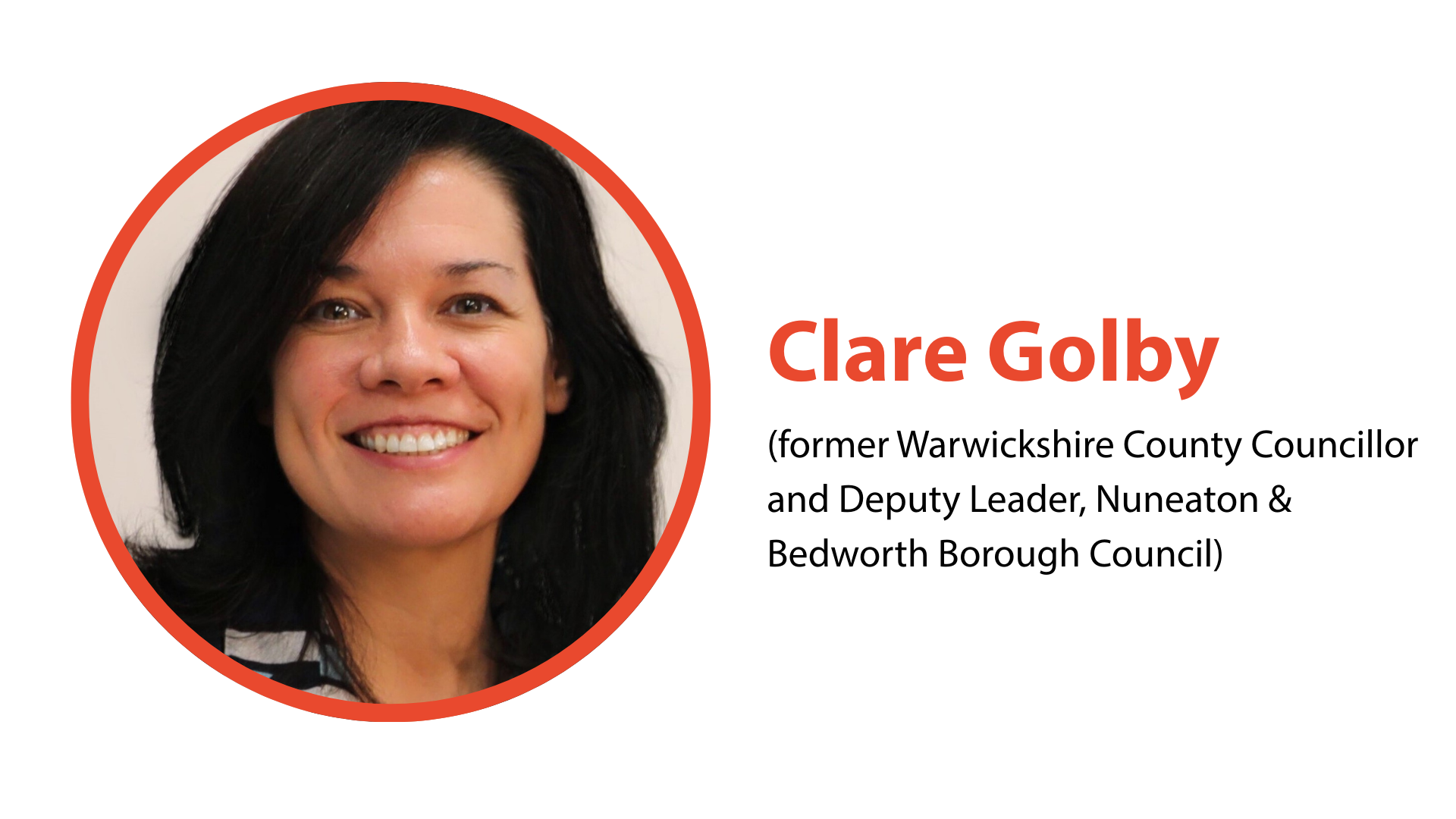In this article, Clare Golby (former Warwickshire County Councillor and Deputy Leader, Nuneaton & Bedworth Borough Council) critiques Warwickshire’s Local Government Reorganisation (LGR), arguing that the move toward a single unitary authority has been politically pre-decided rather than evidence-led. Clare argues how both past and present administrations — Conservative, Labour, and now Reform UK — have sought to use LGR to secure power, while reports have been shaped to justify predetermined outcomes.
The implications of Warwickshire joining the West Midlands Combined Authority could be huge. This article questions who truly holds power in this process — local councils, regional mayors, or central government — and whether Warwickshire’s democratic voice is being side-lined in favour of centralised control.
(October 2025)
Local Government reorganisation has been a hot topic in some circles for a while now. Undulating with peaks and troughs of relevance, bobbing up to the surface only to disappear again while yet another report is written to tell us what we already know.
I served long enough in Warwickshire politics to recognise when a vote is about direction, and when it’s about destination. The recent decision by Warwickshire County Council to pursue a single unitary authority within the wider context of Local Government Reform (LGR) has been presented to the public as an open question, a choice between models, outcomes, and geographies. It was no such thing. The answer was agreed long before the question was asked and not agreed by any local councillors either.
As far back as 2020 the unitarisation of Warwickshire has been a tale of 2 tiers. County and districts separately pushing for wildly different outcomes. The one consistent theme being districts and boroughs advocating for Warwickshire to be split into 2 unitary authorities and Warwickshire County council advocating for a single unitary.
Labour, after gaining most of Warwickshire’s MPs in 2024, viewed LGR through a different lens: a way to stabilise its political position and offset the rise of ‘independent’ mayoral and parliamentary challengers.
Politically, both Labour and the Conservatives once believed that reorganisation in the Midlands would serve their own purposes. After the failed 2020 attempt at unitary under Conservative county leadership, Warwickshire County’s 2023/24 push toward full membership of the West Midlands Combined Authority was as much an attempt at unitary by the back door as it was a supposed strategic safeguard. Labour, after winning most of Warwickshire’s MP seats in 2024, viewed LGR differently. Not as government reform for Warwickshire, but as a way to consolidate power and slow the rise of ‘independent’ mayoral and parliamentary challengers in the wider WMCA footprint.
Both calculations collapsed in May 2025, when Reform UK surged from a standing start and took all but one council seat in the north of the county, also taking control of the County Council administration and rewriting the political map. It is against that backdrop that this LGR must be now understood.
The irony is not subtle. The current Reform UK county administration campaigned during their election for a north/south split, telling voters that divided governance was the best protection against over‑centralisation. Yet now, in the driving seat but without a fresh mandate, it argues that only a single county wide unitary can meet the test [2][3]. Residents have not changed their minds. Leadership has. What happened?
When Evidence Starts Following Decisions
What makes this moment in Warwickshire remarkable is not just the scale of change being proposed, but the ease with which evidence has begun to bend to suit it. The districts and boroughs commissioned their own analysis and quite reasonably concluded that a north and south model offered the most practical route to LGR. Financially balanced, culturally coherent, and reflective of real economic and social divides. Nuneaton & Bedworth Borough Council’s formal position (2 July 2025) explicitly backed a two‑unitary model. North Warwickshire/Nuneaton & Bedworth/Rugby and South Warwickshire (Stratford/Warwick) as the preferred governance option [1]. That stance was reaffirmed by the October 2025 Extraordinary Council call‑up to review the final business case prior to submission to Government [4].
Yet Warwickshire County Council’s own papers asserted something entirely different. That only a single county‑wide unitary could properly meet the Government’s criteria, and the October 2025 report to Council was “prepared … with a leaning towards a single unitary council,” complete with a financial evidence base designed to support that approach [2]. The February 2025 paper similarly framed the invitation and criteria in a way that set up a single unitary as the only model that fully met the tests [3].
Two sets of analyses, drawing on overlapping datasets, arriving at vastly contradictory verdicts. Logic demands that one must be wrong. As a former Conservative Leader once told me “He who pays the piper picks the tune.” The concern, shared quietly across party lines, is that the outcome was set first and that the reports simply plotted a path back to it.
Even central government noticed the inconsistency. In its 3 June 2025 feedback on interim plans, officials cautioned Warwickshire to “use the same assumptions and data sets or be clear where and why there is a difference” and to ground divergence in evidence rather than preference [5]. That is a polite way of saying you can’t both be right.
Warwickshire and the Mayoral Question
To understand what is really at stake, look beyond the county boundary at a major point being skilfully glossed over by all involved. This is not simply a restructuring of councils in Warwickshire, it is a repositioning and formalising of Warwickshire within the wider machinery of West Midlands regional government.
Warwickshire is currently a non‑constituent member of the West Midlands Combined Authority (WMCA), a body with growing powers over transport, skills, housing, and strategic investment. Full membership, which would likely follow a single unitary Council for Warwickshire, would if it joined the West Midlands Combined Authority see a single unitary become the second largest authority at between twice and three times the population of the other authorities. [6]
None of this is inherently bad. Regional collaboration can be beneficial. But it raises a democratic question that has yet to be answered. Who will Warwickshire residents be governed by in ten years’ time? Their local councillors, or a regional authority headquartered outside the county. Does anyone quite understand the wider implications of this? The County’s own interim plan says it plainly: “Full membership of the West Midlands Combined Authority is the logical pathway” to unlock the “fullest suite of devolution benefits” [3]. Logical perhaps for policy integration. Less so for local accountability.
A single Warwickshire unitary would be among the larger authorities in England. Added to the WMCA footprint, it would create one of the most powerful combined authorities in the country with Warwickshire’s distinct identity absorbed into a much larger regional project. That may be a strategic ambition. But it is not being openly debated.
Flattening or Inflating? The Parish Council Illusion
This then leads us on to one of the loudest promises made in support of LGR. Simplicity. We are told this is about “flattening bureaucracy,” “removing duplication,” and “bringing decisions closer to residents.” On paper, those principles are sound. In practice, Warwickshire’s current blueprint risks doing the opposite.
Take Nuneaton & Bedworth. At present, it operates without town or parish councils. A two‑tier model of Borough and County. Under the County’s LGR vision, that structure would not be flattened, but inflated to three tiers or more if membership of the WMCA is also added.
Proposals under Warwickshire County Council LGR are New Unitary Council + Newly‑created Town Councils, + Newly created Parish Councils + Regional Mayoral Authority (WMCA). This is not simplification, its multiplication. While official language speaks of “strengthening local identity” and “neighbourhood empowerment,” those who have served at local level know the reality: parish and town councils vary widely in capability and accountability. In some places they work well, in others they do not exist, and the will to instate them hasn’t been there for good reason.
Alternative: Area Boards and Accountable Localism
Warwickshire needs credible local government reform that strengthens accountability without multiplying bureaucracy or cost to the taxpayer.
During my time on the council, I argued robustly against inflating levels of governance with town or parish councils and for an alternative which preserved the local voice without creating new, taxpayer‑funded fiefdoms. That alternative was area boards. Formal committees made up of elected unitary councillors, rooted in place and entrusted with real decision‑making. No additional precepts. No duplication. No extra layer for residents to navigate.
It will be interesting to see where the district and boroughs go with this when they release their ‘report’ justifying the 2 unitary model. Area board all but forgotten I suspect. Why? Because the introduction of parish councils serves a more subtle purpose. They create the veneer of local control long after the real decisions have moved elsewhere. Political slight of hand.
Area Boards provide that route: democratically elected unitary councillors, grouped by meaningful geographies, with delegated budgets and decision‑making powers. Not symbolic consultation but real authority, real responsibility. Compared to creating or expanding parish/town councils, Area Boards maintain democratic clarity, avoid an extra precept, and keep local decisions in the hands of those residents already elect to make them.
If a unitary must exist, Area Boards offer a principled way to preserve Warwickshire’s distinct communities without fragmenting governance into dozens of small, unevenly resourced parishes. Do what you say you’re going to do. Simplify & flatten the structure. Don’t expand it at the bottom while concentrating it at the top.
The Democratic Question: Will the 2026 Elections Even Matter?
For all the technical language surrounding LGR, one detail should arrest our attention, the possibility that Warwickshire may be redesigning its governance model in such a way that future local elections become, at best, symbolic.
We have been here before. In late 2024, several counties saw their elections postponed in anticipation of structural reform. Warwickshire escaped that initial wave but with full proposals due to be submitted by November 2025, the risk of electoral disruption remains real.
The County’s February 2025 report acknowledges that the Government could decide to postpone County Council elections as part of the reorganisation timetable [3]. They didn’t postpone in May 2025, in part I believe, due to the lobbying of Warwickshire’s majority Labour MP’s, and the belief of ministers that there would be a repeat of the political swing at county level as there was nationally. May 2026 now hangs in the balance and with the looming political threat of Reform UK taking a foothold in those councils who are up for election will Labour’s political nerve hold? If a unitary model is approved before then, an argument could be made that holding elections under the “old system” is redundant. This is a valid point, on cost alone. Elections risk becoming pageantry, a form of democracy without the function but at a cost to the already financially stretched taxpayer. What’s the point of holding elections for what are effectively zombie councils that will cease to exist altogether in a year or two?
For Reform UK now the dominant force in the north this matters deeply.
LGR is not, in itself, something to resist or delay. Structures can and should evolve. Public services require efficiency, coherence, and sustainability. Warwickshire is no exception. But LGR, if it is to command legitimacy, must strengthen the relationship between residents and decision‑makers, not obscure it.
Right now, Warwickshire stands at risk of the opposite. We are being invited to support “streamlining” while being delivered centralisation. We are told this will “bring decisions closer,” while key powers drift towards a regional authority where there is already a troubling disconnect between residents and the role of Mayor. We are offered “local voice,” while new layers of bureaucracy are inserted above and below. It is LGR by slogan not by substance.
The question is not whether Warwickshire can operate as a single council, of course it can. The question is whether it should, and whether residents have been honestly told what that really entails. That local identity will compete with regional gravity. That council elections may become ceremonial and that the choice between one and two unitaries appears to have been settled before consultation truly began [2][5].
Warwickshire and the WMCA members deserve more than pre‑written conclusions dressed as public debate ‘agreed’ by ‘meaningful’ vote during performative council meetings where councillors put forward ‘their’ Deloitte or PwC penned vision for the future.
It deserves thorough, evidence‑led Local Government reform, not what it’s getting now. Choreography and a pretence that the government is ‘listening’ to the results of local consultations where the sample sizes are so small they can’t be considered representative. Or that Whitehall will adopt the outcome of a vote held in a local council chamber by councillors, the majority of whom have most probably not even read the reports they are voting on, let alone understood them or analysed the data beyond the ‘pipers tune’ they are presented with.
And it deserves a full-throated conversation about the WMCA, held in broad daylight, not delivered by appendix.
Because in the end, this is not about structures. It is about sovereignty of place, of people, and of the democratic act itself.
“He who pays the piper picks the tune.” A wry remark indeed. Until that is addressed, the loudest question will remain unanswered: who is paying the piper in this scenario?
In my view, local councils and their councillors are just the percussion section. Does anyone seriously believe that Whitehall is leaving major structural change in local hands? I don’t. Central government already knows exactly how it wants the regional map to look. They should just be honest and get on with it.
[1] Nuneaton and Bedworth Borough Council, Council Agenda, 2 July 2025 – Cabinet recommendation: Local Government Reform – preference for a two‑unitary model – Agenda_and_reports___Council___Wednesday_2nd_July_2025
[2] Warwickshire County Council, Public Reports Pack – County Council 14 October 2025, ‘Local Government Reorganisation in Warwickshire’: report prepared by officers ‘with a leaning towards a single unitary council’, and supporting financial analysis – Public reports pack 14102025 1100 County Council
[3] Warwickshire County Council, ‘Unitary Local Government in Warwickshire’, Council – 18 February 2025; and ‘Interim Plan for Local Government Reorganisation’ – WCCC-1980322935-3102
[4] Nuneaton & Bedworth Borough Council, Letter calling an Extraordinary Council – 1 October 2025, confirming the two‑unitary preference and timetable to submit a final business case by 28 November 2025. – Letter_calling_Extraordinary_Council
[5] DLUHC (formerly MHCLG), ‘Local Government Reorganisation: Interim Plan Feedback: Warwickshire’, 3 June 2025: advises Warwickshire to ‘use the same assumptions and data sets or be clear where and why there is a difference’, and to evidence how each option meets the criteria. WCCC-1980322935-3327
[6] Stratford District Council, Interim plan for local government reorganisation in Warwickshire 20250317 Cabinet Local Government Reorganisation Appendix 2
This is a personal blog post. Any opinions, findings, and conclusion or recommendations expressed in this article are those of the authors and do not necessarily reflect the view of the Centre for the New Midlands or any of our associated organisations/individuals.
ABOUT OUR AUTHOR:
To connect with Clare, visit her LinkedIn page here!








